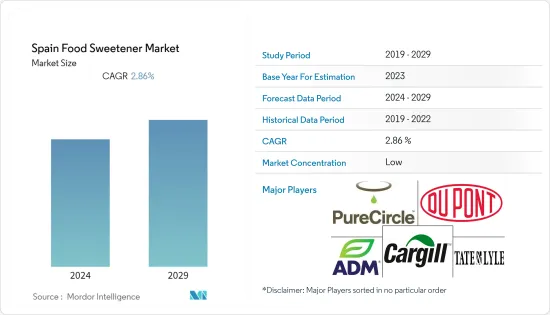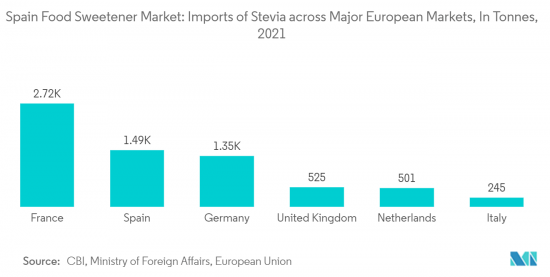PUBLISHER: Mordor Intelligence | PRODUCT CODE: 1403873

PUBLISHER: Mordor Intelligence | PRODUCT CODE: 1403873
Spain Food Sweetener - Market Share Analysis, Industry Trends & Statistics, Growth Forecasts 2024 - 2029

The Spain food sweetener market is valued at USD 1.44 billion for the current year and is projected to register a CAGR of 2.86% during the forecast period.
Key Highlights
- Sweeteners are increasingly used as sugar substitutes in foods and beverages as small amounts are required to achieve the same level of sweetness as sugar. Moreover, the rising rates of diabetic patients have led to the growth of high-intensity sweeteners like sucralose. Unlike sugar, these sweeteners contribute only a few or no calories to the diet and do not raise blood sugar levels. Various studies have shown that sucralose has limited to no effect on factors like carbohydrate metabolism and insulin secretion. Moreover, the exceptional stability of sucralose helps food manufacturers and consumers use it as an alternative to sugar, including in cooking and baking processes.
- Further, the market is witnessing enhanced demand for stevia due to the rising awareness and numerous health benefits associated with its consumption. Consumers are widely substituting sugar with stevia, and many leading food and beverage manufacturers are utilizing it to offer products with a lower calorie count. Thus, the abovementioned factors will likely support the demand and growth of food sweeteners across significant food and beverage applications in Spain.
- However, as per the Mayo Clinic, research reveals that long-term and daily use of sweeteners can lead to a higher risk of stroke, heart disease, and sometimes even death. Sugar alcohols and stevia can cause bloating, gas, and diarrhea. Thus, these factors are bound to restrict the consumption of food sweeteners and hamper market growth to some extent during the forecast years.
Spain Food Sweetener Market Trends
Stevia Witnessing Enhanced Applications across Industries
- Stevia acts as a natural sugar substitute and is about 200 times sweeter than sugar, with a zero-calorie content and minimal harmful effects on health. As a result, consumers are shifting from artificial sweeteners to natural sweeteners. An increase in the demand for nutrition-rich products among consumers seeking healthier lifestyles is expected to bring favorable growth to the market during the forecast period.
- Moreover, stevia is packed with ingredients, such as antioxidant compounds, caffeic acid, quercetin, flavonoids, and tannins, which provide numerous health benefits. As a result, food manufacturers are substituting sugar with stevia in products such as yogurt, tea, and coffee. As the millennial populace opts for low-calorie foods and drinks, the demand for stevia will further increase.
- Moreover, the key players in the stevia market offer customized stevia powder and granules for beverage manufacturers. The natural sweetness stevia offers encourages them to introduce beverage products without compromising the taste and flavor. Stevia extracts in both powder and liquid formats have become an ideal replacement for sugar in most bakery products as they remain stable throughout the baking process. Stevia is a valuable ingredient in dairy applications as well. Its benefits include sugar reduction, superb functionality, stability, and flexibility of use in various dairy food categories, such as yogurt, flavored milk, and ice cream. This thus supports enhanced stevia application and the market for food sweeteners.

Bakery and Confectionery Segment Leading the Application Type
- Sweeteners are one of the essential ingredients in baked goods, and sugar is a widely consumed sweetening agent as it provides a desirable texture and mouthfeel. However, in the long term, too much sugar increases the risk of chronic diseases, such as type 2 diabetes and heart disease. As a result, there has been a significant rise in the demand for food sweeteners as a healthier alternative to sugar. Baked goods can be sweetened with low levels of aspartame in combination with fructose, sorbitol, and xylitol. Sweeteners help at various baking stages, such as avoiding dough rigidity and maintaining the tender crumb texture and volume of the final baked product.
- Furthermore, consumers are becoming conscious of the amount of sugar in their products. According to the 2022 IFIC Food and Health Survey, 73% of consumers are trying to limit or avoid sugar consumption globally. Consumers are looking for bakery and confectionery launches with no sugar or low-calorie sweeteners like stevia. Companies are thus adopting an innovative and sustainable approach to offer food sweeteners that can be used in a wide range of bakery and confectionery applications. Therefore, rising applications and product innovations support the demand for food sweeteners in the country.
Spain Food Sweetener Industry Overview
The Spain food sweetener market is a highly competitive market with the presence of well-established players in the market. Major players are bringing innovations in their product offerings and are expanding their product portfolio to maintain their position in the market. Players also focus on natural and clean-label products as consumers become more health-conscious. Prominent players in the market include Tate & Lyle Plc, Cargill Incorporated, Archer Daniels Midland Company, and DuPont, among others.
Additional Benefits:
- The market estimate (ME) sheet in Excel format
- 3 months of analyst support
TABLE OF CONTENTS
1 INTRODUCTION
- 1.1 Study Assumptions and Market Definition
- 1.2 Scope of the Study
2 RESEARCH METHODOLOGY
3 EXECUTIVE SUMMARY
4 MARKET DYNAMICS
- 4.1 Market Drivers
- 4.1.1 Shift towards Natural Sweeteners
- 4.2 Market Restraints
- 4.2.1 Health Concerns Related to Sweetener Consumption
- 4.3 Porter's Five Forces Analysis
- 4.3.1 Bargaining Power of Suppliers
- 4.3.2 Bargaining Power of Buyers
- 4.3.3 Threat of New Entrants
- 4.3.4 Threat of Substitute Products
- 4.3.5 Intensity of Competitive Rivalry
5 MARKET SEGMENTATION
- 5.1 By Type
- 5.1.1 Sucrose
- 5.1.2 Starch Sweeteners and Sugar Alcohols
- 5.1.2.1 Dextrose
- 5.1.2.2 High Fructose Corn Syrup (HFCS)
- 5.1.2.3 Maltodextrin
- 5.1.2.4 Sorbitol
- 5.1.2.5 Xylitol
- 5.1.2.6 Other Starch Sweetners and Sugar Alcohols
- 5.1.3 High Intensity Sweeteners(HIS)
- 5.1.3.1 Sucralose
- 5.1.3.2 Aspartame
- 5.1.3.3 Saccharin
- 5.1.3.4 Cyclamate
- 5.1.3.5 Ace-K
- 5.1.3.6 Neotame
- 5.1.3.7 Stevia
- 5.1.3.8 Other High Intensity Sweetners
- 5.2 By Application
- 5.2.1 Dairy
- 5.2.2 Bakery
- 5.2.3 Soups, Sauces and Dressings
- 5.2.4 Confectionery
- 5.2.5 Beverages
- 5.2.6 Other Applications
6 COMPETITIVE LANDSCAPE
- 6.1 Most Adopted Strategies
- 6.2 Market Share Analysis
- 6.3 Company Profiles
- 6.3.1 Tate & Lyle Plc
- 6.3.2 Cargill Incorporated
- 6.3.3 Archer Daniels Midland Company
- 6.3.4 DuPont
- 6.3.5 PureCircle Limtied
- 6.3.6 NutraSweet Company
- 6.3.7 Tereos S.A.
- 6.3.8 AB Azucarera Iberia S.L.
- 6.3.9 Biostevera S.L
- 6.3.10 Azucares Prieto
7 MARKET OPPORTUNITIES AND FUTURE TRENDS
8 ABOUT US




